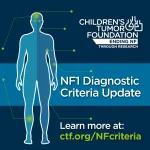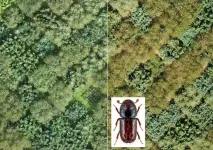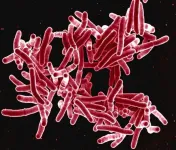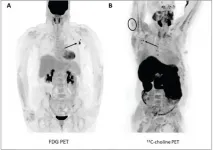A safer, greener way to make solar cells: researchers find replacement for toxic solvent
2021-05-19
(Press-News.org) Scientists at SPECIFIC Innovation and Knowledge Centre, Swansea University, have found a way to replace the toxic, unsustainable solvents currently needed to make the next generation of solar technology.
Printed carbon perovskite solar cells have been described as a likely front runner to the market because they are extremely efficient at converting light to electricity, cheap and easy to make.
A major barrier to the large-scale manufacture and commercialisation of these cells is the solvents used to control crystallisation of the perovskite during fabrication: this is because they are made from unsustainable materials and are banned in many countries due to their toxicity and psychoactive effects.
SPECIFIC's researchers have discovered that a non-toxic biodegradable solvent called γ-Valerolactone (GVL) could replace these solvents without impacting cell performance.
GVL's list of advantages could improve the commercial viability of carbon perovskite solar devices:
It is made from sustainable feedstocks
There are no legal issues in its use around the world
It is suitable for use in large-scale manufacturing processes
It is non-toxic and biodegradable
Carys Worsley, who led the research as part of her doctorate, said:
"To be truly environmentally sustainable, the way that solar cells are made must be as green as the energy they produce. As the next generation of solar technologies approaches commercial viability, research to reduce the environmental impact of large-scale production will become increasingly important."
Professor Trystan Watson, research group leader, added:
"Many problems need to be resolved before these technologies become a commercial reality. This solvent problem was a major barrier, not only restricting large-scale manufacture but holding back research in countries where the solvents are banned.
We hope our discovery will enable countries that have previously been unable to participate in this research to become part of the community and accelerate the development of cleaner, greener energy."
INFORMATION:
The research was made possible with funding from the UKRI Global Challenge Research Fund SUNRISE project and through funding of the SPECIFIC Innovation and Knowledge Centre by the Engineering and Physical Science Research Council, Innovate UK, and the European Regional Development Fund through the Welsh Government.
It was published in Energy Technology
Notes to editors:
Swansea University is a world-class, research-led, dual campus university offering a first-class student experience and has one of the best employability rates of graduates in the UK. The University has the highest possible rating for teaching - the Gold rating in the Teaching Excellence Framework (TEF) in 2018 and was commended for its high proportions of students achieving consistently outstanding outcomes.
Swansea climbed 14 places to 31st in the Guardian University Guide 2019, making us Wales' top ranked university, with one of the best success rates of graduates gaining employment in the UK and the same overall satisfaction level as the Number 1 ranked university.
The 2014 Research Excellence Framework (REF) 2014 results saw Swansea make the 'biggest leap among research-intensive institutions' in the UK (Times Higher Education, December 2014) and achieved its ambition to be a top 30 research University, soaring up the league table to 26th in the UK.
The University is in the top 300 best universities in the world, ranked in the 251-300 group in The Times Higher Education World University rankings 2018. Swansea University now has 23 main partners, awarding joint degrees and post-graduate qualifications.
The University was established in 1920 and was the first campus university in the UK. It currently offers around 350 undergraduate courses and 350 postgraduate courses to circa 20,000 undergraduate and postgraduate students. The University has ambitious expansion plans as it moves towards its centenary in 2020 and aims to continue to extend its global reach and realise its domestic and international potential.
Swansea University is a registered charity. No.1138342. Visit http://www.swansea.ac.uk
For more information:
Kevin Sullivan, senior press officer, Swansea University k.g.sullivan@swansea.ac.uk
Follow us on Twitter: http://www.twitter.com/SwanseaUni
Find us on Facebook: http://www.facebook.com/swanseauniversity
[Attachments] See images for this press release:
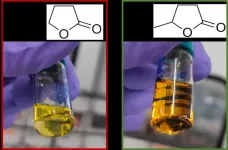
ELSE PRESS RELEASES FROM THIS DATE:
2021-05-19
ITHACA, N.Y. - For the first time, Cornell University researchers have developed a technique for studying the neuroscience of motor control in mice ¬- by focusing on a mouse's tongue when it licks a water spout.
The technique incorporates high-speed cameras and machine learning in a tractable experimental setup that opens the door for revealing mysteries of how the motor cortex works, understanding the neural basis of related disorders like Parkinson's disease, and informing robots.
"We now have an approach in a mouse where we can bring all the tools of modern neuroscience to bear on this really classic problem of motor control," said senior author Jesse Goldberg, associate professor of neurobiology and behavior.
The field of motor control neuroscience has made advancements ...
2021-05-19
Updated Criteria Also Released for Legius Syndrome and Mosaic NF
NF2 and Schwannomatosis Diagnostic Criteria to Be Released Later This Year
The Children's Tumor Foundation (CTF) today announced the publication of updated diagnostic criteria for the genetic disorder neurofibromatosis type 1 (NF1) in Genetics in Medicine, the official journal of the American College of Medical Genetics and Genomics. The new publication is the result of an extensive, multi-year collaborative effort of over 90 leading neurofibromatosis (NF) experts from around the globe, and is aimed at improving the accuracy and earlier diagnosis of NF1 in patients, thus ultimately leading to improved care and quality of life for those patients. ...
2021-05-19
Open up Scott Roy's Twitter bio and you'll see a simple but revealing sentence: "The more I learn the more I'm confused." Now the rest of the scientific world can share in his confusion. The San Francisco State University associate professor of Biology's most recent research, published earlier this month in one of the scientific world's most prestigious journals, catalogues a strange and confounding system of genes in a tiny rodent that scientists have ignored for decades.
"This is basically the weirdest sex chromosome system known to science," Roy said. "Nobody ordered this." But he's serving it anyway.
The owner of those chromosomes is the creeping vole, a burrowing rodent native to the Pacific Northwest. Scientists ...
2021-05-19
In recent years, foresters have been able to observe it up close: First, prolonged drought weakens the trees, then bark beetles and other pests attack. While healthy trees keep the invaders away with resin, stressed ones are virtually defenseless. Freiburg scientist Sylvie Berthelot and her team of researchers from the Faculty of Environment and Natural Resources and the Faculty of Biology are studying the importance of tree diversity on bark beetle infestation. They are investigating whether the composition of tree species affects bark beetle feeding behavior. The team recently published their findings in the Journal of Ecology.
In a 1.1 hectare experimental set-up in Freiburg, six native deciduous and coniferous tree species from Europe and six deciduous and coniferous ...
2021-05-19
SAN ANTONIO (May 19, 2021) -- Four months of multi-drug therapy that included rifapentine and moxifloxacin treated active tuberculosis (TB) as effectively as the standard six-month regimen in a multinational study, cutting treatment time by a third. Coauthors including Marc Weiner, MD, of The University of Texas Health Science Center at San Antonio, reported the findings May 6 in the New England Journal of Medicine.
"Shorter treatment would be easier for people to complete without missing doses, and ultimately may be cost-effective," said Dr. Weiner, associate professor in the health science center's Joe R. and Teresa Lozano END ...
2021-05-19
A team of researchers at the Centre Spatial de Liège (CSL) of the University of Liège has just developed a method to identify the contributors and origins of stray light on space telescopes. This is a major advance in the field of space engineering that will help in the acquisition of even finer space images and the development of increasingly efficient space instruments. This study has just been published in the journal Scientific Reports.
Space telescopes are becoming more and more powerful. Technological developments in recent years have made it possible, for example, to observe objects further and further into the universe or to measure the composition of the Earth's atmosphere with ever greater precision. However, there is still one factor limiting the performance ...
2021-05-19
HAMILTON, ON (May 19, 2021) - Researchers have found that the inclusion of a third drug to commonly used dual-drug inhalers can reduce asthma exacerbations and improve control over the disease in children, adolescents, and adults with moderate-to-severe asthma.
A team from McMaster University and The Research Institute of St. Joe's Hamilton announced their findings from a systematic review and meta-analysis. Data from 20 randomized controlled trials, which included a total of almost 12,000 patients, were analyzed in the study.
Dual-drug inhalers used to treat asthma typically contain an inhaled corticosteroid (ICS) to reduce inflammation, as well as a long-acting beta-adrenoceptor agonist (LABA) that acts as a bronchodilator. High-certainty evidence showed that the inclusion of a third ...
2021-05-19
Leesburg, VA, May 19, 2021--According to an open-access article in ARRS' American Journal of Roentgenology (AJR), increased axillary lymph node or ipsilateral deltoid uptake is occasionally observed on FDG or 11C-choline PET performed after Pfizer-BioNTech or Moderna COVID-19 vaccination.
"Recognition of occasional abnormal axillary lymph node or deltoid uptake on PET examinations performed after COVID-19 vaccination will aid interpreting physicians and reduce unnecessary biopsies," wrote corresponding author Jason R. Young from the department of radiology at Mayo Clinic in Rochester, MN.
Young and colleagues' retrospective study included ...
2021-05-19
For the first time, geological records have been used to reconstruct the history of Larsen C Ice Shelf in Antarctica. The ice shelf is the largest remaining remnant of a much more extensive area of ice on the Antarctic Peninsula that began to break up during the 1990s (Larsen A), and saw a huge collapse in 2002 (Larsen B). This new reconstruction enables scientists to better understand if and when the remaining ice shelf could collapse in the future.
Publishing this month in the journal Geology an international team describes how the largest remaining ice shelf on the Antarctic ...
2021-05-19
By mapping its genetic underpinnings, researchers at University of California San Diego School of Medicine have identified a predictive causal role for specific cell types in type 1 diabetes, a condition that affects more than 1.6 million Americans.
The findings are published in the May 19, 2021 online issue of Nature.
Type 1 diabetes is a complex autoimmune disease characterized by the impairment and loss of insulin-producing pancreatic beta cells and subsequent hyperglycemia (high blood sugar), which is damaging to the body and can cause other serious health problems, such as heart disease and vision loss. Type 1 is less common than type 2 diabetes, but its prevalence is growing. The U.S. Centers for Disease ...
LAST 30 PRESS RELEASES:
[Press-News.org] A safer, greener way to make solar cells: researchers find replacement for toxic solvent

